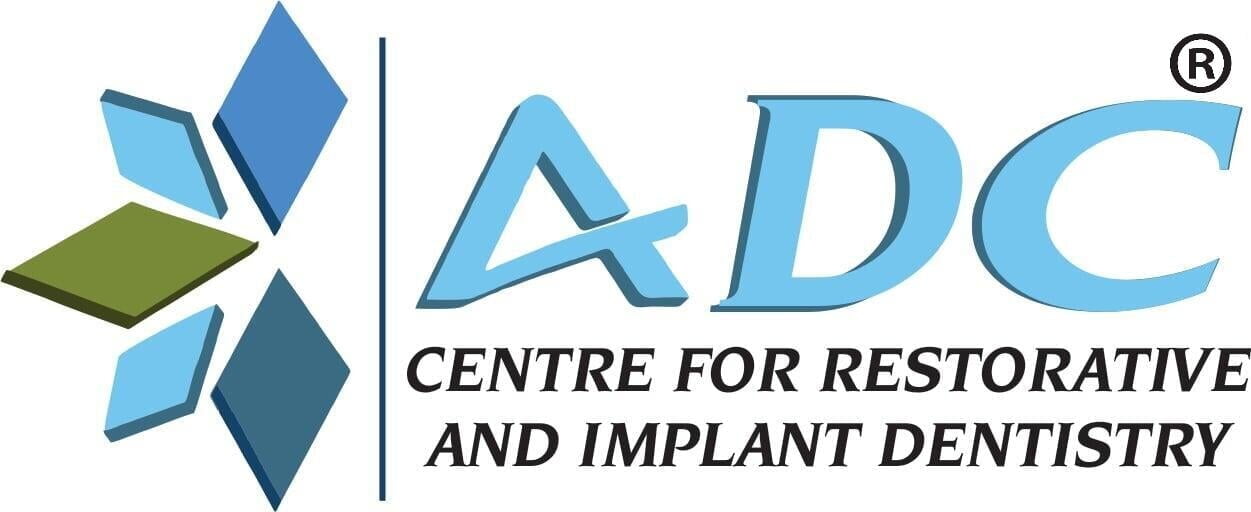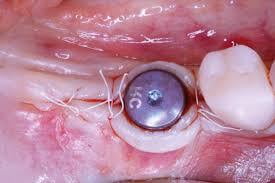
Dental Implant Treatment Stage II is also known as "Uncovering stage" or "Gingival Abutment placement" or "Healing Abutment placement" stage. Your Dentist has decided to proceed with Dental Implant Treatment Stage II once sufficient healing time has lapsed after the Stage I and your Implants have fused with your jaw bone. If your implant was “buried” under the tissues, the implants were uncovered and a “healing abutment” or "Gingival Abutment" was placed. A Gingival Abutment is a small, round component that is attached to the implant which contours and shapes the gum tissue so it is ready for the impressions and final steps. You must wait from 5 Days to 2 weeks after the uncover and healing cap placement appointment before seeing your general dentist for the final impressions.
Immediately after Gingival Abutment placement
Apply Pressure: It is normal to experience some postoperative bleeding and this can be stopped once you apply mild pressure to the gauze/ cotton placed. You should keep the sterile gauze on the surgical site with some pressure- by closing the Jaw hard until the bleeding from the surgical site stops.
Use Cold Compress: Applying a cold compress using an ice pack is an excellent way to avoid the swelling in the treated area. This can be used for at least half an hour to forty five minutes immediately post-surgery.
Eating an Ice-cream: Eating an ice-cream after the procedure acts as a cold compress for your swelling.
Avoid Spitting: You should not spit for the rest of the day and also avoid spitting for next 24 hours.
Avoid touching the area with tongue or fingers: Avoid touching the Gingival Abutment or Healing Abutment with your tongue or fingers to minimize the irritation and chance of infection.
Avoid Smoking: Smoking after having dental implants surgery can adversely affect your chances of a successful healing. Nicotine reduces oxygen flow to your bones and tissue which results in longer healing time and increased chance of infection. Smoking is also a factor to cause severe gums and periodontal diseases. This results in smokers having a higher chance of implant failure than non-smokers. Hence, it is recommended to quit or avoid smoking during your recovery period.
For Swelling
It is normal for most Patients to experience some swelling after Dental Implants Stage II surgery. Swelling can be mild or severe. It differs from patient to patient. The swelling is generally higher for first 48 hours before it starts subsiding. Sometimes it may last for several days. Some bruises may also appear on the face.
- You can use an ice pack on the face or cheek next to the surgical site. Apply it for 15 to 30 minutes with an interval of 10 minutes and repeat until you sleep. Repeat the ice packs the next day.
- Please get in touch with the front desk if you encounter nausea and vomiting.
- On day three, switch to Luke warm saline rinses instead of ice packs. Luke warm water with a table spoon of common salt helps in increased blood circulation, which reduces the swelling.
Sutures
The dental office will reschedule your appointment after 7 to 10 days to remove the sutures if any.
Eat Soft Diet
Avoid hot and crunchy hard food for the first 24hrs. You can eat soft food after dental implant surgery as the local anaesthesia wears off. Avoid chewing directly from the Gingival Abutment site. You can resume a regular diet if you feel you are up to it. Please stay well hydrated and nourished as this will help you heal faster. In the first 48 hrs post surgery, it is strictly recommended to have soft diet that minimizes the irritation and food lodgement in the Gingival Abutment site.Try to keep food away from the surgical area for as long as possible. Rinse after eating to keep the area clean.
Practise Good Oral Hygiene
You can brush your teeth, avoiding the Gingival Abutment site area next day morning. Be gentle and avoid spiting or rinsing forcefully. You have to be very gentle. Rinse your toothbrush under hot water to soften the bristles and avoid vigorous extensive rinsing. Rinse the mouth keep the area clean following every meal so that food particles do not get stuck in the treated area..This will reduce the chances of developing an infection around the Gingival Abutment site. Using the antibiotic mouthwash as prescribed by your doctor also helps in reducing the chance of infection. These are a list of cleaning products that can be used to clean the treated area:
- Toothbrush: Use a soft bristles toothbrush to remove food debris and plaque accumulation as they will prevent gum damage as well as disruption of the blood clot . Electric toothbrush with soft bristles can also be used as it works more effectively than manual toothbrushes due to greater number of strokes generated than the human hand.
- Water Flosser: A dental flosser/ water flosser is an oral health appliance that provides a stream of pulsating water to floss between your teeth and below the gumline. They are design and attached with rubber-tip stimulators and other attachments to effectively clean difficult to access areas as deep as 6 mm . Most dentists recommend water flossers over dental floss due to their ease of use and effective cleaning.
- Sulcus Brush: It is a specialized brush for cleaning and removing food debris and plaque from the gums and below the gumline into the sulcus. It is one-third the size of a regular toothbrush and can be used in a gentle back & forth sweeping motion at the level where your tooth and gum meet. It makes dental implants and denture care more easier and effective.
Salt Water Rinsing
You can start rinsing the next day (after 24 hours) gently with some Luke warm salty water 6 to 8 times a day. Avoid using alcohol containing mouth rinses and mouthwashes for next few days. Sometimes facial muscles stiffness can cause problems in mouth opening for several days. Luke warm saline rinses and heat compression can provide great relief. To make a salt water rinse, add 1 teaspoon of salt to a cup of warm water. Once the salt dissolves, you can gently swish the mixture in your mouth for about 30 seconds and then spit it out once you are done.This helps to decrease the amount of bacteria inside the mouth without causing irritation to the incision. Read benefits of Salt Water Rinses in Detail.
Medication
You were probably given one or more prescriptions for medication. Take all medications with a full glass of water and as directed. Call us immediately if you complain of diarrhea or nausea, any allergic reactions or unable to swallow your pain pills.
- Antibiotic: Continue the antibiotics as prescribed by doctor. Do not leave the medication halfway.
- Pain Medicine: Continue the pain medicine as prescribed. Remember that some pain medicines or narcotics can make you feel sleepy, so avoid driving, working or consuming alcoholic drinks.
- Mouth Rinse: Chloro-hexidine mouth wash or Listerine. Swish for forty seconds, and spit. Use it atleast two times a day.
Rest as much as you Can
Join the movement #paperless
Going Paperless can help save the Earth from climate change and biodiversity loss. It is a big task, but we know we can do it together. Get Help in going Paperless.
Medical Disclaimer:
The content of ADC-Centre for Restorative and Implant Dentistry's Blog/website is for information only, not advice or guarantee of any outcome. Information is gathered and shared from reputable sources; however, ADC-Centre for Restorative and Implant Dentistry is not responsible for errors or omissions in reporting or explanation. No individuals, including those under our active care, should use the information, resources or tools contained within to self-diagnosis or self-treat any health-related condition. ADC-Centre for Restorative and Implant Dentistry gives no assurance or warranty regarding the accuracy, timeliness or applicability or the content.
ADC-Centre for Restorative and Implant Dentistry accepts no liability for errors, inaccuracies, omission, or misleading statements. ADC-Centre for Restorative and Implant Dentistry excludes liability for any losses, demands, claims or damages of any kind regarding information, content, or services at this blog/website. The information may be updated at any time, especially as medical/dental discoveries and research evolves regarding the dentistry and its conditions. At no time does ADC-Centre for Restorative and Implant Dentistry take any responsibility for any action taken or care chosen in reliance on information contained in this blog or this website.
















